[Here’s a link to other forays around my map.]
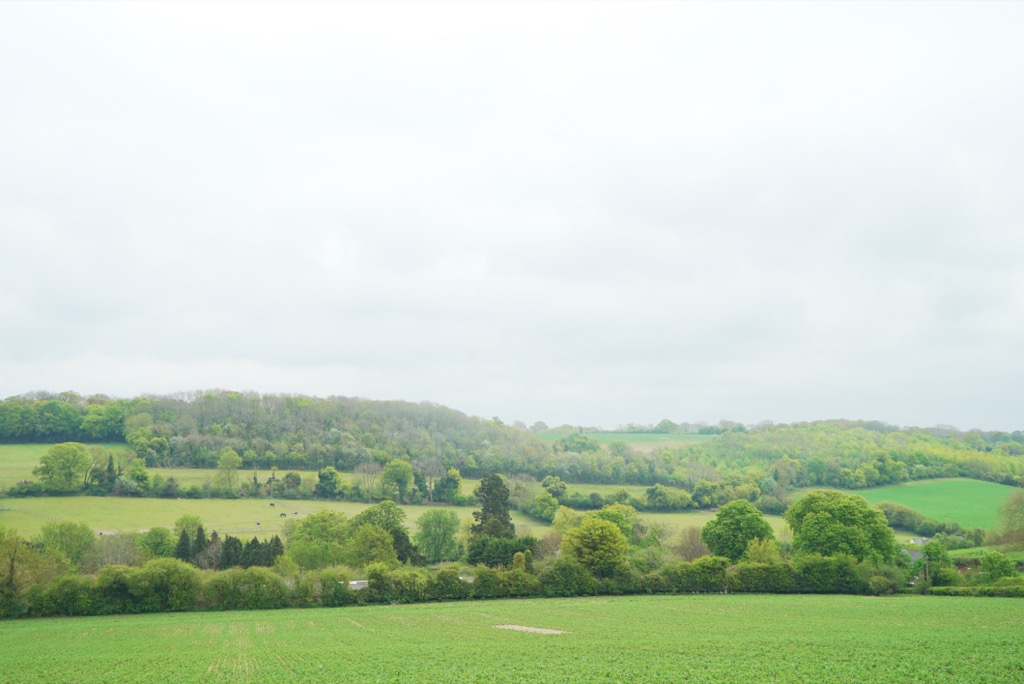
You should sit in nature for twenty minutes everyday, they say, unless you’re too busy; then you should sit for an hour. Today I sat on the bench on the small, triangular village green because I thought I was too busy to be doing this today, because as I enter the second half of my year exploring this single map I had a hunch that I had probably seen everything there was to see and because this square looked quite dull on the map. It only took a couple of minutes of stillness for me to settle into it and slow my impatient, rushing mind. The morning was cold and blustery. I was back in my hat and gloves, hunkering deep down into my collar.
A sign on the green said the village was supporting ‘No Mow May‘ and its grass was peppered with wild flowers. The reason for thinking twice about our mowing habits comes down to stark facts. According to a report in the journal Biological Conservation, 97 per cent of British wildflower meadows have disappeared since the 1930s. A recent study published in the journal Nature Communications shows that many British pollinating insects are in decline, with rarer species, such as the red-shanked carder bee, really struggling. Between 1980 and 2013, every square kilometre in the UK lost an average of 11 species of bee and hoverfly. The reasons behind this are the use of insecticides, habitat loss and an overall reduction in biodiversity. Plantlife believes that people’s gardens can play a vital part in reversing this trend.

Cycling out of the village, my first stop was at a field absolutely covered in buttercups.
Most British children have, at some time, had a buttercup held under their chin in the traditional “test” to see if they liked butter. But Ranunculus, to give buttercups their Latin name, has a darker folklore attached to it than those innocent-looking, golden flowers. According to legend, Ranunculus was a young boy who lived many, many years ago, who always dressed from head to toe in gold and green silk. He spent his days running round the trees of the forest singing in a beautiful, clear, high-pitched voice. And he never, ever stopped. The wood nymphs, realising this was disturbing the peace of the forest and all the creatures in it, turned him into a buttercup and sent him out into the open meadow to live; thereby restoring peace and harmony.
In the Pacific region of north America the buttercup is known as Coyote’s Eye. In the legend, Coyote was tossing his eyes up in the air and catching them again when Eagle snatched them. Unable to see, Coyote made new eyes from the buttercup.
In Sardinia the Ranunculus Sardos was said to cause anyone stupid enough to eat it to develop a contorted grin to their face – sometimes followed by death – which it is thought may have given rise to the expression, Sardonic smile.
And despite Buttercup being a favourite name for pet cattle, no sensible cow would munch fresh buttercups because of the irritation and toxicity caused by the sap. As a plant, the buttercup was unusually said to have no medicinal purpose, although it was claimed that medieval beggars would rub the irritant sap into their skin to create sores, in the hope of gaining more sympathy – and money.
If you’ve ever played the childhood game of holding a buttercup under your chin to see if you like butter, you might have wondered why the cheery little flowers are the only type that provide the requisite reflection on your skin. A new study reveals the answer: Buttercups are unique among flowers. Their bright-yellow gloss results from a one-of-a-kind combination of pigments and anatomical structures that create an optical thin film. These films reflect light much like a sheen of oil on a parking-lot puddle. Pigmented thin films haven’t been found in flowers before.
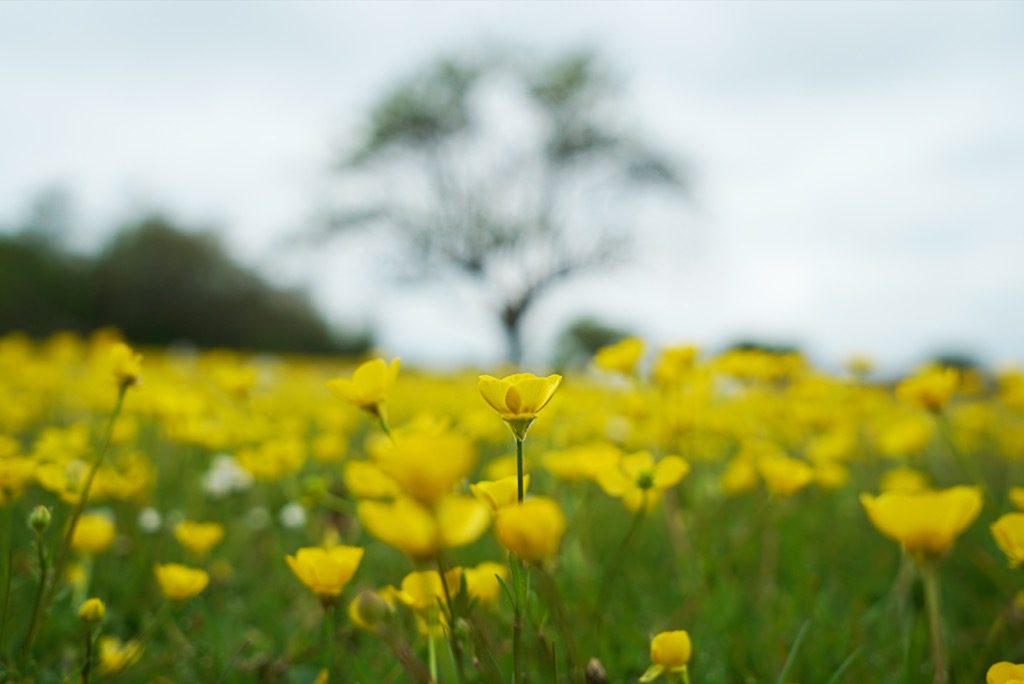
I tend to cycle around the grid squares with my camera slung on my back, stopping often to photograph anything that catches my eye. I had just pulled over to photograph a field of buttercups when a lawn mower (the job description, not the machine) stopped his van, wound down the window and asked, ‘What lens are you using?’
An odd request, and not what you usually expect when a white van man winds down his window to speak to you, but I’m always happy to talk lenses with anyone interested.
‘A 24-70 f4,’ I said. ‘Not wide enough to be wide, not zoomed enough for the long shots. A bit annoying all round, but quite a useful all-rounder.’
It turned out that the man did not actually want to ask me about my camera equipment. He wanted to tell me about his own. On the seat beside him was a camera bag and he spent about ten minutes pulling out lenses and telling me all about them. I liked his enthusiasm. He said that he loved his job mowing lawns. ‘I go to some pretty nice places, so I always take my gear with me. There’s loads of stuff to photograph.’
It struck me that both of us were going about similar things in different ways. We both liked seeing new places, capturing them, sharing them, and had gone about finding jobs that allowed us to get out and do what we enjoyed.

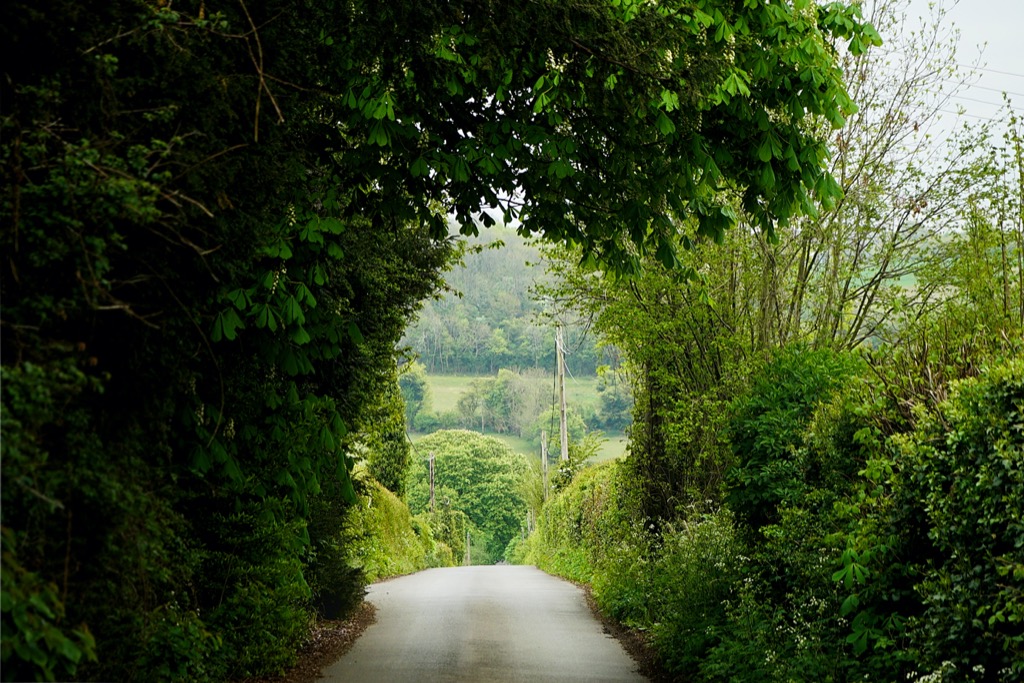
I wished him well and made my way into some woods to make coffee. I was pleased to see that these woods were managed by The Woodland Trust, a conservation charity I’m fond of. They describe themselves thus, ‘We plant woods and trees to combat climate change, build a greener future for the UK and create havens for wildlife. We bring damaged ancient woods back to life. We restore these irreplaceable ecosystems so wildlife can thrive once again. We save woods and trees from decimation. We stand against needless destruction and lead the fight against tree pests and diseases. We care for over 1,000 woods, keeping them open for you to explore and enjoy. We want to inspire a love for woods and trees for generations to come.’
A sign pointed out that that many ash trees had been felled in this wood to help manage ash dieback.
Ash dieback will kill around 80% of ash trees across the UK. At a cost of billions, the effects will be staggering. It will change the landscape forever and threaten many species which rely on ash. This is going to have a devastating impact on the landscape and the biodiversity of our woodlands, as well as a major loss in connections between habitats as we lose hedges and individual trees outside of woods.
Finding a chain-sawed ash tree in a beautiful clearing of bluebells I made the most of the sad situation by manoeuvring a smooth white slab of ash wood to make a perfect coffee table. So pleased was I with this that I even used the spirit level app on my phone to ensure it was perfectly level! As I fired up my stove to boil water I admired my handiwork.
Used to ascertain whether a surface is level on a horizontal surface or plumb, or for vertical accuracy, the history of the spirit level is thought to date back as far as the early 15th Century. The spirit level was invented by Melchisedech Thevenot. Melchisedech was a wealthy Frenchman and although known as a royal librarian for King Louis XIV, was in fact an amateur mathematician and scientist. He noticed how, in order for a bubble in a tube of water (or spirit) to be positioned centrally, it required the tube be mounted on a surface that was exactly horizontal. From these early findings circa. 1661, further developments were made. However, it was not until the early 18th Century that the spirit level is thought to have widespread use. (Thévenot is also famous for his popular 1696 book The Art of Swimming, one of the first books on the subject and widely read during the 18th century (Benjamin Franklin, an avid swimmer in his youth, is known to have read it). The book popularised the breaststroke; he was inducted into the International Swimming Hall of Fame in 1990.)


Soon my moka pot was roaring happily and I turned off the gas stove to enjoy the sudden silence and the dark, strong coffee. The moka pot is a symbol of Italy: of postwar ingenuity and global culinary dominance. It is in the Museum of Modern Art, the Cooper-Hewitt Smithsonian Design Museum, and other temples to design. It is in the Guinness Book of World Records as the world’s most popular coffee maker, and was for decades commonplace to the point of ubiquity not only in Italy but in Cuba, Argentina, Australia, and the United States.
The various species of Coffea, the seeds of which are dried, roasted, and ground to make coffee, are native to east Africa, particularly Ethiopia. Coffee as a beverage first shows up in the historical record—which is not necessarily to say that it wasn’t consumed in its native Ethiopia first—in what is now Yemen. It spread quickly throughout the Middle East, North Africa, and firmly established itself as part of the culture in what are now Turkey and Iran.
Europeans were late to the coffee party, but Italy, sharing the Mediterranean with the Arab and Greek worlds and not really very far from North Africa, was probably the gateway for coffee to spread westward. But for centuries after its introduction to Venice in the early 17th century, coffee was seen as an Arab affectation, something foreign and alternately exotic and threatening.
Italians began coming up with their own gadgets for brewing coffee in the 19th century, but the biggest by far was the idea of applying pressure to coffee in order to create a strong, and more importantly fast, drink. This is the age of steam, a miraculous source of power that can unlock the world, and though it’s not entirely clear who originated the idea of using steam to brew coffee, certainly it was in Italy that it was popularized.
In 1918, a Piedmontese metalworker named Alfonso Bialetti returned home after a decade spent working with aluminum in France. Industrial production of aluminum was new, then; methods for working with it at any real scale had only been developed in 1886. He opened a shop, crafting strong, lightweight aluminum versions of pots and pans that had previously been only available in iron. Legend has it that the idea for the moka pot came from a laundry boiler, though that’s not confirmed. It is a small metal device with three sections: a chamber of water, a small puck of coffee in the middle, and a chamber on the other end for brewed coffee. It uses steam power to force hot water through the coffee. The characteristic hourglass shape, with the eight-sided chambers, was there from the beginning.
Over the next 60 years, the moka pot would conquer the world. As of 2016, the New York Times notes that over 90 percent of Italian homes had one. It became so iconic that Renato Bialetti, when he died in early 2016, was actually buried in a large replica of the moka pot.
The moka pot’s struggles began in the 1990s, and came in two forms. One, I think, is very interesting, but is not as large a factor in the demise of the moka pot as some might believe. The other is very boring and very obvious and is almost certainly the big problem. The latter is that people, in Italy and elsewhere, love coffee pods. Coffee pods, especially Nespresso, are wildly popular in Italy, because they are easy. I have very little else to say about coffee pods.
The former problem, the more interesting one, took place within the coffee-nerd world. Inspired by Italian espresso bar culture, Starbucks almost single-handedly changed the entire concept of coffee in America. And the moka pot was not part of that. Espresso machines, then and now, are gigantic, expensive, difficult to use, and incredibly inefficient from an energy perspective. They do not really make sense for the home. But Americans tried anyway, replacing their Mr. Coffees and French presses with underpowered home espresso machines, ignoring the entire time that there was another option, the one Italians used all along.
The nice thing about the moka pot is that it can create a very nice cup of strong coffee, and that the equipment you need is wholly affordable. Moka pots cost about 30 bucks, and by using good coffee and a bit of technique, you can make as good an example of moka pot coffee as anyone in the world.
I packed away my things and cycled out of the wood, past the most impressive of all the homemade dens I have seen in woodland over recent months. Not only was there the typical conical shelter built from sticks (though this one was 12-feet high and had involved some serious work), but also a second shelter, a woven wooden wall and a seating area of large logs.
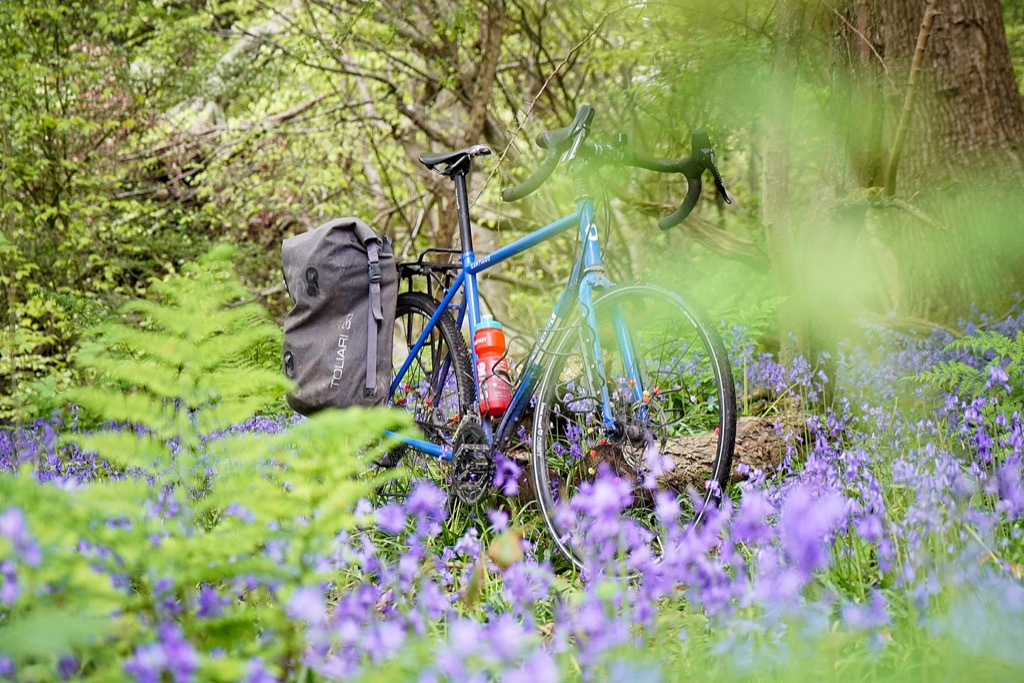
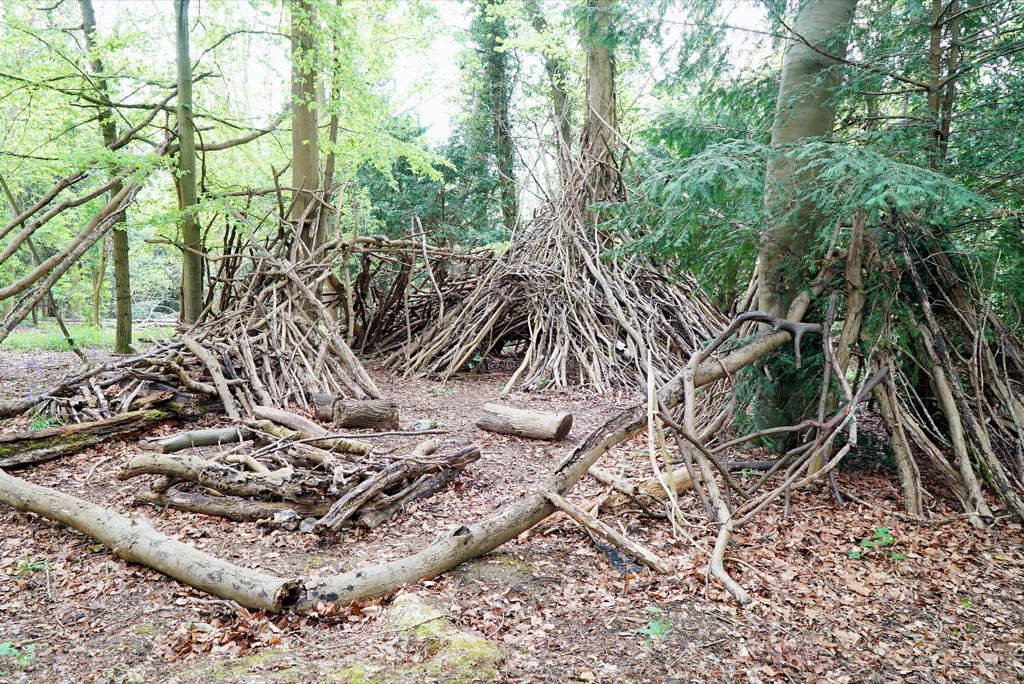
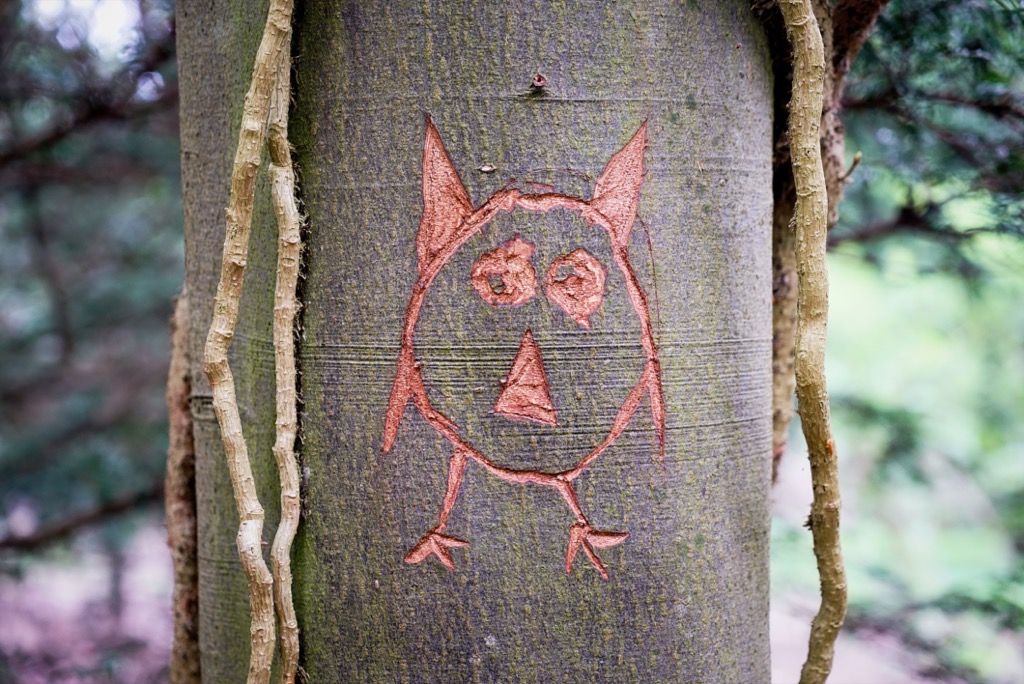
A free-wheeling, no-handed downhill ride is one of the great delights of life and one that I hope I never grow out of. I flew happily down through a tunnel of green trees towards the village nestled at the foot of the valley. The hills are steep in this grid square – one even had me out of the saddle in a granny gear sort of climb. I pulled over to look at a field which was half wheat, half wild pasture. The difference between the crazy green monoculture of the fertilised crop and the haphazard variety of the meadow sprinkled with dozens of varieties of plants (purple ground ivy, crosswort, burdock amongst them) was a clear illustration of the environmental impact of feeding so many humans.
At my feet a few ladybirds were going about things their own way, foraging for lunch on a patch of nettles. The name “ladybird” originated in Britain where the insects became known as “Our Lady’s bird” or the Lady beetle. Mary (Our Lady) was often depicted wearing a red cloak in early paintings, and the spots of the seven-spot ladybird (the most common in Europe) were said to symbolise her seven joys and seven sorrows. Common names in some other European languages have the same association; for example, the German name Marienkäfer translates to Marybeetle.
Many cultures consider ladybirds lucky and have nursery rhymes or local names for the insects that reflect this. For instance, the Turkish name for the insect is uğur böceği, literally meaning ‘good luck bug’. In many countries, including Russia, Turkey, and Italy, the sight of a coccinellid is either a call to make a wish or a sign that a wish will soon be granted. Sometimes, the insect is referred to as belonging directly to God (Irish bóín Dé, Polish boża krówka, Russian божья коровка [bozhya korovka], all meaning ‘God’s [little] cow’). In Dutch it is called lieveheersbeestje, meaning ‘little animal of our Good Lord’. In both Hebrew and Yiddish, it is called “Moshe Rabbenu’s (i.e., Moses’s) little cow” or “little horse”, apparently an adaptation from Slavic languages. Occasionally, it is called “little Messiah”.
I remembered the nursery rhyme ‘Ladybird, ladybird’ but hadn’t remembered its grisly lyrics…
- Ladybird, ladybird fly away home,
- Your house is on fire and your children are gone,
- All except one, and her name is Ann,
- And she hid under the baking pan.
A shorter, grimmer version concludes:
- Your house is on fire,
- Your children shall burn!
Mind you, nursery rhymes are often pretty brutal once you take notice.
Take, for example,
Mary Mary quite contrary,
How does your garden grow?
With silver bells and cockleshells
And pretty maids all in a row.
Two 16th-century queens have a claim to this beloved nursery rhyme: Mary Queen of Scots and Bloody Mary. Both queens’ husbands supposedly cheated on them, and “cockleshells” may refer to this. Bloody Mary was renowned for torturing Protestants, and “silver bells” was a nickname for the thumbscrews, while “cockleshells” were believed to be instruments of torture attached to the genitals. She failed to produce an heir and “How does your garden grow?” is a taunt of this. “Pretty maids all in a row” could either refer to stillborn children, or perhaps to a device called a maiden, which was used to behead people.
On a quiet lane I passed four or five people each walking a pair of greyhounds on leads, an outing to stretch their legs from the professional greyhound trainer I passed shortly after. Modern greyhound racing has evolved from a form of hunting called coursing, in which a dog runs after a live game animal – usually a rabbit or hare.
I made my way back up to the top of the valley, along narrow strips of footpath fenced off from broad horse meadows by electric fences. The horses had more right to roam around here than I did! It was a beautiful valley, green and wooded in all directions. I like being able to see the whole of the day’s grid square, getting a feeling for the lie of the land and realising quite how large a single square kilometre is when you travel slowly across it. I can hear kids playing outside at the school down in the valley, birds singing in the wood, and lorries trundling along the nearby motorway. The oak leaves are coming through now, and the world is looking verdant, lush and green. I felt transformed, restored, transcended – entirely different to when I arrived here this morning.




Comments